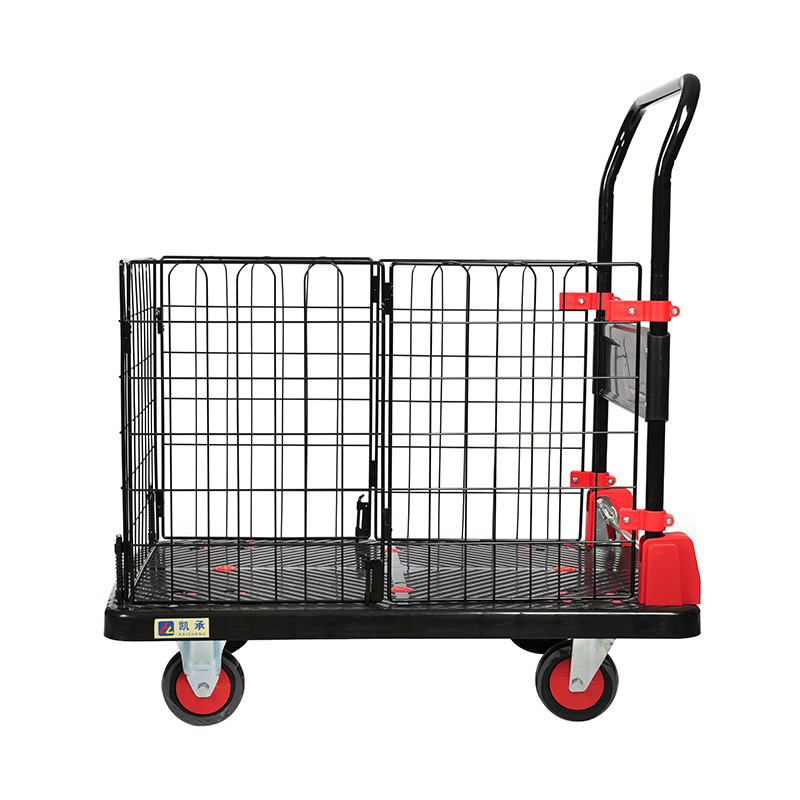Under high load conditions, metal foldable trolleys may deform or fail due to stress concentration, material fatigue or design defects. To prevent these problems, optimization is required from multiple aspects such as material selection, structural design, manufacturing process and maintenance. The following is a detailed analysis and solution:
1. Material selection and strength optimization
(1) High-strength metal materials
The use of high-strength metal materials (such as aluminum alloy, stainless steel or high-strength carbon steel) can significantly improve the trolley's anti-deformation ability and load-bearing performance.
Aluminum alloy: light weight and corrosion resistance, suitable for scenarios with high portability requirements.
Stainless steel: has excellent corrosion resistance and strength, suitable for humid or dusty environments.
High-strength carbon steel: provides higher rigidity and load-bearing capacity, but attention should be paid to rust prevention.
(2) Composite material combination
Introducing composite materials (such as carbon fiber reinforced plastics) in key parts (such as frame connections or support points) can reduce weight and improve strength.
(3) Heat treatment and surface strengthening
Heat treatment (such as quenching and tempering) of metal materials to improve their hardness and fatigue resistance.
Surface strengthening technology (such as carburizing, nitriding or spraying ceramic coating) can further enhance the wear resistance and pressure resistance of key components.
2. Structural design optimization
(1) Rib design
Adding ribs to the frame and panel of the trolley can effectively disperse stress and improve overall rigidity.
The arrangement of ribs should be optimized according to stress distribution to avoid excessive concentration or waste of materials.
(2) Reasonable load distribution
Ensure that the load is evenly distributed on the frame structure during design to avoid deformation caused by local overload.
Finite element analysis (FEA) is used to simulate the stress distribution under high load conditions and optimize the structural design.
(3) Double-layer or multi-layer frame
For trolleys with high load-bearing requirements, a double-layer or multi-layer frame design can be adopted to increase structural stability.
The connection between the frames should be firm and reliable to avoid looseness or slippage.
(4) Folding mechanism reinforcement
The folding mechanism is the weak link of the trolley and is prone to deformation or failure under high load conditions.
The stability of the folding mechanism can be improved by adding a locking device (such as a spring lock or bolt fixing).
The folding hinge part can adopt a multi-point support design to reduce the single-point force.
3. Connection method and manufacturing process
(1) Welding and riveting
The welding point should be as smooth as possible and free of pores to avoid stress concentration caused by welding defects.
Riveting or bolting is more flexible than welding and can provide better shear resistance under high loads.
(2) Precision machining
The machining accuracy of key components (such as hinges and axles) directly affects the stability of the overall structure.
Use CNC machining or laser cutting technology to ensure that the component dimensions are accurate and well matched.
(3) Anti-loosening design

Bolts, nuts and other connectors should adopt anti-loosening design (such as spring washers or self-locking nuts) to avoid loosening due to vibration.
4. Wheel and support system optimization
(1) Wheel material and structure
Using high-strength wheels (such as polyurethane or rubber tires) can improve load-bearing capacity and durability.
Increasing the number of wheels (such as four-wheel or six-wheel design) or using wide wheels can disperse ground pressure and reduce impact on the frame.
(2) Bearing type
Use high-quality ball bearings or needle bearings to improve the smoothness and load-bearing capacity of the wheels.
Lubricate the bearings regularly to reduce friction loss.
(3) Center of gravity distribution
The design of the trolley should ensure that the center of gravity is located between the wheel axles to avoid tipping over or structural failure caused by center of gravity shift.
Under high load conditions, the center of gravity can be stabilized by adding bottom support rods or bottom plates.
5. Testing and verification
(1) Static load-bearing test
After the design is completed, the trolley is subjected to a static load-bearing test to verify whether its deformation under rated load meets the requirements.
During the test, record the stress changes in key parts and optimize the weak links.
(2) Dynamic fatigue test
Simulate the dynamic loads in actual use scenarios (such as repeated folding, pushing and vibration) to evaluate the fatigue life of the trolley.
Adjust the material thickness or connection method according to the test results.
(3) Extreme test
Perform overload test to evaluate the safety margin of the trolley under extreme conditions.
Ensure that the trolley can still maintain a certain degree of integrity when the rated load is exceeded.
6. User recommendations
(1) Avoid overloading
Clearly mark the rated load of the trolley and guide users to avoid long-term overloading.
Provide load distribution recommendations to avoid concentrating heavy objects in one area.
(2) Regular inspection and maintenance
Regularly inspect the key components of the trolley (such as the folding mechanism, wheels and connectors) and replace worn or loose parts in a timely manner.
Clean the surface of the trolley to avoid corrosion or dirt accumulation that affects the structural strength.
(3) Storage and transportation
When not in use, store the trolley in a dry and ventilated place to avoid long-term exposure to humid environments.
Store properly after folding to avoid permanent deformation caused by squeezing.
Under high load conditions, preventing metal folding trolleys from deformation or structural failure requires comprehensive consideration of material selection, structural design, manufacturing process, and use and maintenance. By optimizing materials, strengthening structures, improving connection methods, and conducting rigorous testing and verification, the trolley's load capacity and service life can be significantly improved. In addition, the user's correct use and regular maintenance are also important factors in ensuring the long-term and stable operation of the trolley.


 English
English Español
Español



